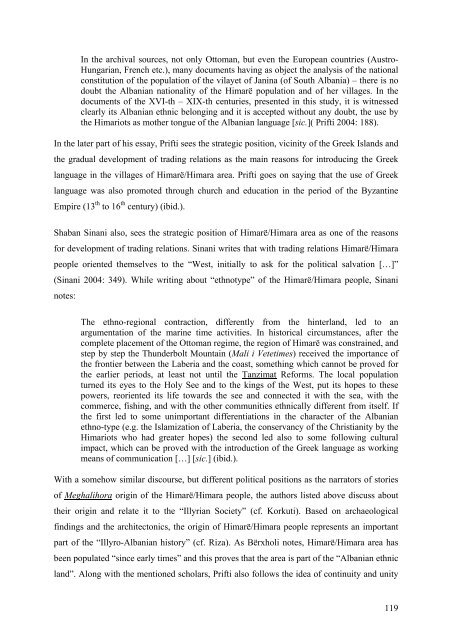university of nova gorica graduate school contested spaces and ...
university of nova gorica graduate school contested spaces and ...
university of nova gorica graduate school contested spaces and ...
Create successful ePaper yourself
Turn your PDF publications into a flip-book with our unique Google optimized e-Paper software.
In the archival sources, not only Ottoman, but even the European countries (Austro-<br />
Hungarian, French etc.), many documents having as object the analysis <strong>of</strong> the national<br />
constitution <strong>of</strong> the population <strong>of</strong> the vilayet <strong>of</strong> Janina (<strong>of</strong> South Albania) – there is no<br />
doubt the Albanian nationality <strong>of</strong> the Himarë population <strong>and</strong> <strong>of</strong> her villages. In the<br />
documents <strong>of</strong> the XVI-th – XIX-th centuries, presented in this study, it is witnessed<br />
clearly its Albanian ethnic belonging <strong>and</strong> it is accepted without any doubt, the use by<br />
the Himariots as mother tongue <strong>of</strong> the Albanian language [sic.]( Prifti 2004: 188).<br />
In the later part <strong>of</strong> his essay, Prifti sees the strategic position, vicinity <strong>of</strong> the Greek Isl<strong>and</strong>s <strong>and</strong><br />
the gradual development <strong>of</strong> trading relations as the main reasons for introducing the Greek<br />
language in the villages <strong>of</strong> Himarë/Himara area. Prifti goes on saying that the use <strong>of</strong> Greek<br />
language was also promoted through church <strong>and</strong> education in the period <strong>of</strong> the Byzantine<br />
Empire (13 th to 16 th century) (ibid.).<br />
Shaban Sinani also, sees the strategic position <strong>of</strong> Himarë/Himara area as one <strong>of</strong> the reasons<br />
for development <strong>of</strong> trading relations. Sinani writes that with trading relations Himarë/Himara<br />
people oriented themselves to the “West, initially to ask for the political salvation […]”<br />
(Sinani 2004: 349). While writing about “ethnotype” <strong>of</strong> the Himarë/Himara people, Sinani<br />
notes:<br />
The ethno-regional contraction, differently from the hinterl<strong>and</strong>, led to an<br />
argumentation <strong>of</strong> the marine time activities. In historical circumstances, after the<br />
complete placement <strong>of</strong> the Ottoman regime, the region <strong>of</strong> Himarë was constrained, <strong>and</strong><br />
step by step the Thunderbolt Mountain (Mali i Vetetimes) received the importance <strong>of</strong><br />
the frontier between the Laberia <strong>and</strong> the coast, something which cannot be proved for<br />
the earlier periods, at least not until the Tanzimat Reforms. The local population<br />
turned its eyes to the Holy See <strong>and</strong> to the kings <strong>of</strong> the West, put its hopes to these<br />
powers, reoriented its life towards the see <strong>and</strong> connected it with the sea, with the<br />
commerce, fishing, <strong>and</strong> with the other communities ethnically different from itself. If<br />
the first led to some unimportant differentiations in the character <strong>of</strong> the Albanian<br />
ethno-type (e.g. the Islamization <strong>of</strong> Laberia, the conservancy <strong>of</strong> the Christianity by the<br />
Himariots who had greater hopes) the second led also to some following cultural<br />
impact, which can be proved with the introduction <strong>of</strong> the Greek language as working<br />
means <strong>of</strong> communication […] [sic.] (ibid.).<br />
With a somehow similar discourse, but different political positions as the narrators <strong>of</strong> stories<br />
<strong>of</strong> Meghalihora origin <strong>of</strong> the Himarë/Himara people, the authors listed above discuss about<br />
their origin <strong>and</strong> relate it to the “Illyrian Society” (cf. Korkuti). Based on archaeological<br />
findings <strong>and</strong> the architectonics, the origin <strong>of</strong> Himarë/Himara people represents an important<br />
part <strong>of</strong> the “Illyro-Albanian history” (cf. Riza). As Bërxholi notes, Himarë/Himara area has<br />
been populated “since early times” <strong>and</strong> this proves that the area is part <strong>of</strong> the “Albanian ethnic<br />
l<strong>and</strong>”. Along with the mentioned scholars, Prifti also follows the idea <strong>of</strong> continuity <strong>and</strong> unity<br />
119

















